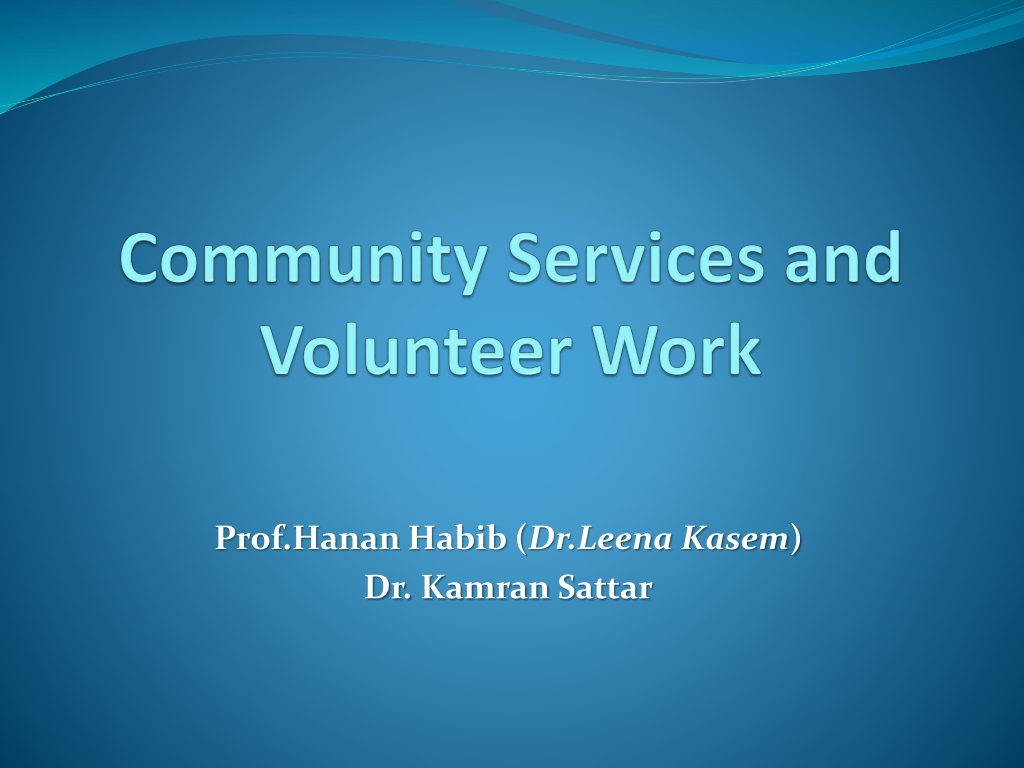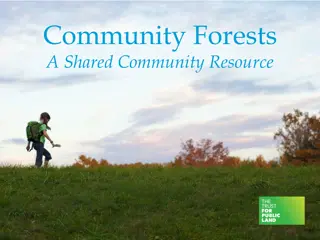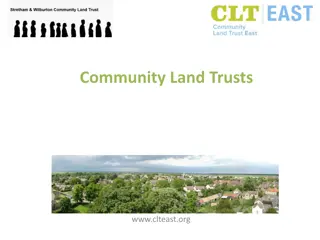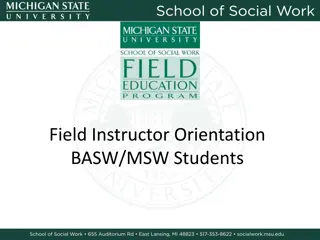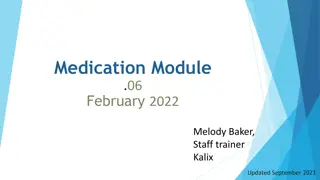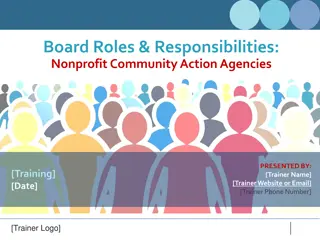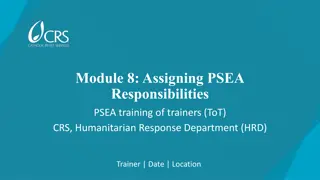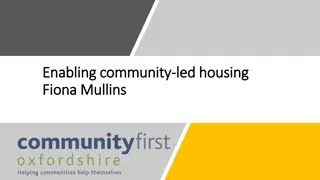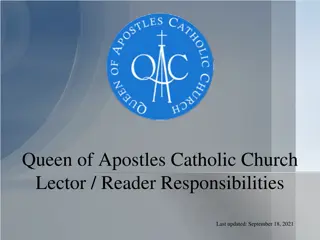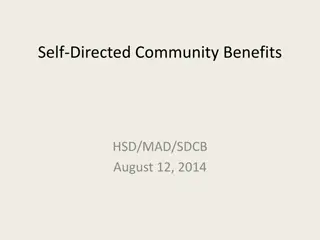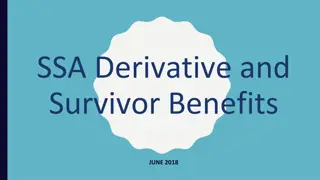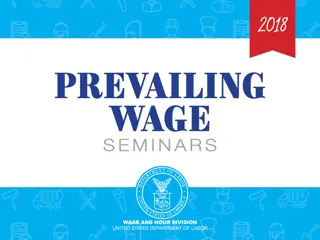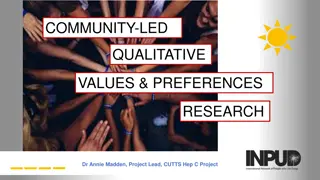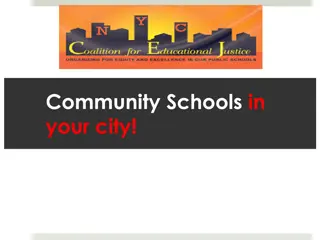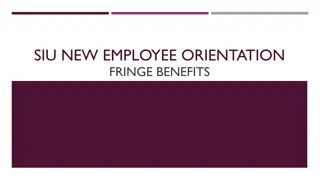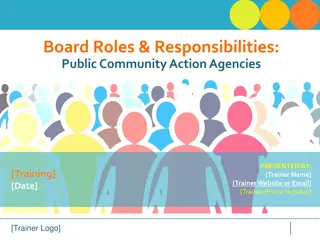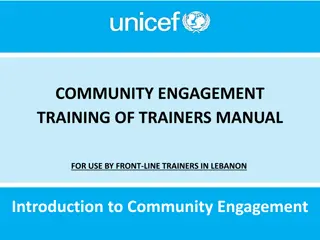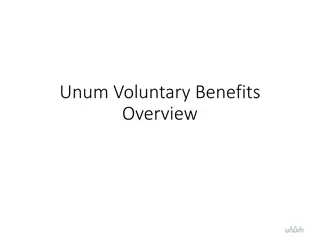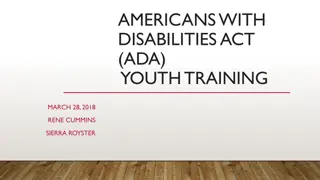Understanding Community Service: Responsibilities and Benefits Explored
Exploring the concept of community service and its significance in society. From volunteer work to altruistic acts, discover how community service benefits both individuals and the public. Learn about the evolving definition of community, the role of volunteers, and the diverse ways in which community service can positively impact communities.
Download Presentation

Please find below an Image/Link to download the presentation.
The content on the website is provided AS IS for your information and personal use only. It may not be sold, licensed, or shared on other websites without obtaining consent from the author. Download presentation by click this link. If you encounter any issues during the download, it is possible that the publisher has removed the file from their server.
E N D
Presentation Transcript
Prof.Hanan Habib (Dr.Leena Kasem) Dr. Kamran Sattar
The concept of community service. The social, public and community responsibilities of the professionals. The concept and types of volunteer work.
The word "community" is derived from the old French communit which is derived from the Latin communitas (cum, "with/together" + munus, "gift"), a broad term for fellowship or organized society. (Oxford University Press)
Community is a group of interacting people, living in the same proximity (in space, time, or relationship). Community usually refers to a social unit larger than a household that shares common values and has social cohesion.
Community service is defined as donated service or activity that is performed by someone or a group of people for the benefit of the public or its institutions.
Some people associate community service with punishment, since it is often offered to small-time offenders as an alternative to fines or jail time. However, community service can also be altruistic, and it is a vital part of many small communities.
Basically anything which benefits the society in any way can be considered as a community service project or activity.
In most cases, community service work is performed by volunteers who are not paid for their time.
Community Services includes: Visiting and spending time with lonely elderly . Tutoring needy students in their studies for free. Helping out at organizations such as libraries.
Benefits the community The volunteers in the activities also gain a sense of accomplishment Better social communication skills Exposure to new peoples and cultures Overall improved mental health When you cease to make a contribution, you begin to die. Anna Eleanor Roosevelt (October 11, 1884 November 7, 1962)
Physicians are members of the community. Responsibilities of physicians are not limited to those within the hospital and clinical care.
Usually the focus is on the physician - patient relation. The broader sense of responsibility of physicians is towards their community
Physicians role in the community extends to: Public Health Prevention of illnesses Educational roles Improving health care access Setting policies Assurance of competency International Aid Fund raising
Health depends not only on medical care but also on other factors including: 1. Individual behavior 2. Genetic makeup 3. Social and economic conditions
Social Genetic Environmental Psychological
Many entities ( health stakeholders ) in the community share the responsibility of maintaining and improving its health.
Health care providers Public health agencies Community organizations Government agencies Schools Social services organizations
1. Monitor health status to identify community health problems. 2. Diagnose and investigate health problems and health hazards in the community. 3. Inform, educate, and empower people about health issues. 4. Mobilize community partnerships to identify and solve health problems. 5. Develop policies and plans that support individual and community health efforts.
6. Enforce laws and regulations that protect health and ensure safety. 7. Link people to needed personal health services and assure the provision of health care when otherwise unavailable. 8. Assure a competent public and personal health care workforce. 9. Evaluate effectiveness, accessibility and quality of personal and population-based health services. 10. Research for new insights and innovative solutions to health problems.
-The science and practice of preventing diseases and promoting health in populations . -It depends largely on epidemiology. -Largely performed by governmental organizations.
Traditional objective: To control communicable diseases Safety of water and food supply Response to national disasters
Educating the public about: oCauses of illness oPreventive measures oPredisposing factors oChanges in lifestyle
Improve the level and ease of access of individuals to health care services by reducing inequalities.
-In some areas of the world, health care is very limited and almost non- existent -Most people suffer from diseases such as Malaria, Tuberculosis, Typhoid, and AIDS. -Many of the illnesses can be improved or eliminated by basic medical care and other measures .
Done through: Organizations providing humanitarian needs Medical Organizations Governments
They provide: Clean water supplies Clothing Education
Medical teams provide: 1. Medical care 2. Medications 3. Immunizations 4. Medical supplies 5. Teach communities about nutrition and preventive measures 6. Training of local health care providers
Aid to other countries during time of need. May include sending: Medical professionals Medical equipments Medications
May not apply locally since health care services are provided by the governments. Funds may be raised to help those individuals who cannot afford to purchase medications or medical equipments.
Volunteering is generally considered an altruistic activity, intended to improve human quality of life.
For their own skill development. To solve problems when needed To make contacts for possible employment. To help others and earn respect and favor. Get benefit of spare time. A variety of other reasons.
Types of Volunteer Work Skill based volunteering : special skills required. Micro & virtual- volunteering : off-site tasks done by internet . Completed in certain time .May need application process or training, eg. Tele-monitoring ,tele-tutoring. Environmental volunteering: eg. Protecting animals, education about natural environment. Emergency volunteering : during natural disasters. School volunteering: additional teaching for students.
Types of Volunteer Work Community volunteering: for orphanages, widows, mosques, blood donation, during Hajj and Ramadan,..etc. International Work Camps : environmental conservation, rural developments, etc. Volunteering can be daily ,for hours ,weekly or when needed . It can be done through: money, donations, work effort, or relations .
Volunteering in Islam ( : ( ( .) ) ( ( ) ( : )
1. Integrity 2. Altruism 3. Continuous improvement 4. Excellence ,as well as ; 5. Working in partnership with members of the other health care teams.
The broader concept of physician role should be adopted to go past the individual and include the community as well.
You have been given this life but once in it, do all the good that you can do to all the people you can do for as long as you can do . Ceccere
1. An Introduction to Community Health James F. McKenzie 2. Community Health and Wellness: Primary Health Care in Practice Anne McMurray and Jill Clendon 3. Volunteers: a social profile Indiana University Press, 2008 - Social Science Marc A. Musick, John Wilson32 Reviewshttp://books.google.com.sa/books/about/Volunteers.html?id=u8Tabf5H cRcC Indiana University Press, 2008
